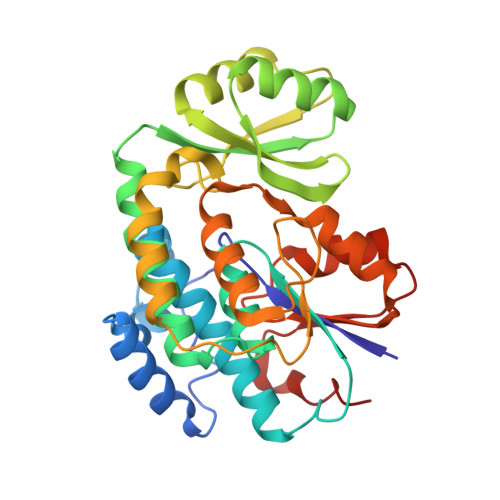The Crystal Structure of MCAT from Mycobacterium tuberculosis Reveals Three New Catalytic Models.
Li, Z., Huang, Y., Ge, J., Fan, H., Zhou, X., Li, S., Bartlam, M., Wang, H., Rao, Z.(2007) J Mol Biol 371: 1075-1083
- PubMed: 17604051
- DOI: https://doi.org/10.1016/j.jmb.2007.06.004
- Primary Citation of Related Structures:
2QC3 - PubMed Abstract:
The malonyl coenzyme A (CoA)-acyl carrier protein (ACP) transacylase (MCAT) plays a key role in cell wall biosynthesis in Mycobacterium tuberculosis and other bacteria. The M. tuberculosis MCAT (MtMCAT) is encoded by the FabD gene and catalyzes the transacylation of malonate from malonyl-CoA to holo-ACP. Malonyl-ACP is the substrate in fatty acid biosynthesis and is a by-product of the transacylation reaction. This ability for fatty acid biosynthesis enables M. tuberculosis to survive in hostile environments, and thus understanding the mechanism of biosynthesis is important for the design of new anti-tuberculosis drugs. The 2.3 A crystal structure of MtMCAT reported here shows that its catalytic mechanism differs from those of ScMCAT and EcMCAT, whose structures have previously been determined. In MtMCAT, the C(beta)-O(gamma) bond of Ser91 turns upwards, resulting in a different orientation and thus an overall change of the active pocket compared to other known MCAT enzymes. We identify three new nucleophilic attack chains from the MtMCAT structure: His90-Ser91, Asn155-Wat6-Ser91 and Asn155-His90-Ser91. Enzyme activity assays show that His90A, Asn155A and His90A-Asn155A mutants all have substantially reduced MCAT activity, indicating that M. tuberculosis MCAT supports a unique means of proton transfer. Furthermore, His194 cannot form part of a His-Ser catalytic dyad and only stabilizes the substrate. This new discovery should provide a deeper insight into the catalytic mechanisms of MCATs.
Organizational Affiliation:
Tsinghua-Nankai-IBP Joint Research Group for Structural Biology, Tsinghua University, Beijing 100084, China.















